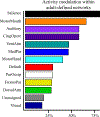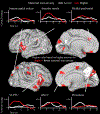Neonatal Brain Response to Deviant Auditory Stimuli and Relation to Maternal Trait Anxiety
- PMID: 33900811
- PMCID: PMC8363512
- DOI: 10.1176/appi.ajp.2020.20050672
Neonatal Brain Response to Deviant Auditory Stimuli and Relation to Maternal Trait Anxiety
Abstract
Objective: Excessive response to unexpected or "deviant" stimuli during infancy and early childhood represents an early risk marker for anxiety disorders. However, research has yet to delineate the specific brain regions underlying the neonatal response to deviant stimuli near birth and the relation to risk for anxiety disorders. The authors used task-based functional MRI (fMRI) to delineate the neonatal response to deviant stimuli and its relationship to maternal trait anxiety.
Methods: The authors used fMRI to measure brain activity evoked by deviant auditory stimuli in 45 sleeping neonates (mean age, 27.8 days; 60% female; 64% African American). In 41 of the infants, neural response to deviant stimuli was examined in relation to maternal trait anxiety on the State-Trait Anxiety Inventory, a familial risk factor for offspring anxiety.
Results: Neonates manifested a robust and widespread neural response to deviant stimuli that resembles patterns found previously in adults. Higher maternal trait anxiety was related to higher responses within multiple brain regions, including the left and right anterior insula, the ventrolateral prefrontal cortex, and multiple areas within the anterior cingulate cortex. These areas overlap with brain regions previously linked to anxiety disorders and other psychiatric illnesses in adults.
Conclusions: The neural architecture sensitive to deviant stimuli robustly functions in newborns. Excessive responsiveness of some circuitry components at birth may signal risk for anxiety and other psychiatric disorders.
Keywords: Anxiety Disorders; Child/Adolescent Psychiatry; Development; Neuroimaging.
Figures




Similar articles
-
Antenatal maternal anxiety predicts variations in neural structures implicated in anxiety disorders in newborns.J Am Acad Child Adolesc Psychiatry. 2015 Apr;54(4):313-21.e2. doi: 10.1016/j.jaac.2015.01.013. Epub 2015 Jan 30. J Am Acad Child Adolesc Psychiatry. 2015. PMID: 25791148
-
Maternal Systemic Interleukin-6 During Pregnancy Is Associated With Newborn Amygdala Phenotypes and Subsequent Behavior at 2 Years of Age.Biol Psychiatry. 2018 Jan 15;83(2):109-119. doi: 10.1016/j.biopsych.2017.05.027. Epub 2017 Jun 19. Biol Psychiatry. 2018. PMID: 28754515 Free PMC article.
-
[Application of simultaneous auditory evoked potentials and functional magnetic resonance recordings for examination of central auditory system--preliminary results].Otolaryngol Pol. 2011 May-Jun;65(3):171-83. doi: 10.1016/S0030-6657(11)70671-0. Otolaryngol Pol. 2011. PMID: 21916216 Polish.
-
Altered Task-Evoked Corticolimbic Responsivity in Generalized Anxiety Disorder.Int J Mol Sci. 2021 Mar 31;22(7):3630. doi: 10.3390/ijms22073630. Int J Mol Sci. 2021. PMID: 33807276 Free PMC article. Review.
-
Neuroimaging and neuromodulation approaches to study eating behavior and prevent and treat eating disorders and obesity.Neuroimage Clin. 2015 Mar 24;8:1-31. doi: 10.1016/j.nicl.2015.03.016. eCollection 2015. Neuroimage Clin. 2015. PMID: 26110109 Free PMC article. Review.
Cited by
-
Precision Functional Neuroimaging Reveals Individually Specific Auditory Responses in Infants.bioRxiv [Preprint]. 2025 Aug 4:2025.08.04.667740. doi: 10.1101/2025.08.04.667740. bioRxiv. 2025. PMID: 40799538 Free PMC article. Preprint.
-
Functional parcellation of the neonatal brain.bioRxiv [Preprint]. 2023 Nov 11:2023.11.10.566629. doi: 10.1101/2023.11.10.566629. bioRxiv. 2023. Update in: Cereb Cortex. 2024 Jan 31;34(2):bhae047. doi: 10.1093/cercor/bhae047. PMID: 37986902 Free PMC article. Updated. Preprint.
-
An ode to fetal, infant, and toddler neuroimaging: Chronicling early clinical to research applications with MRI, and an introduction to an academic society connecting the field.Dev Cogn Neurosci. 2022 Apr;54:101083. doi: 10.1016/j.dcn.2022.101083. Epub 2022 Feb 7. Dev Cogn Neurosci. 2022. PMID: 35184026 Free PMC article. Review.
-
Precision Functional Mapping to Advance Developmental Psychiatry Research.Biol Psychiatry Glob Open Sci. 2024 Aug 8;4(6):100370. doi: 10.1016/j.bpsgos.2024.100370. eCollection 2024 Nov. Biol Psychiatry Glob Open Sci. 2024. PMID: 39309212 Free PMC article. Review.
-
Baby Brains at Work: How Task-Based Functional Magnetic Resonance Imaging Can Illuminate the Early Emergence of Psychiatric Risk.Biol Psychiatry. 2023 May 15;93(10):880-892. doi: 10.1016/j.biopsych.2023.01.010. Epub 2023 Jan 20. Biol Psychiatry. 2023. PMID: 36935330 Free PMC article. Review.
References
-
- Kessler RC, Berglund P, Demler O, Jin R, Merikangas KR, Walters EE. Lifetime prevalence and age-of-onset distributions of DSM-IV disorders in the National Comorbidity Survey Replication. Archives of General Psychiatry. 2005;62:593–602. - PubMed
-
- Piacentini J, Bennett S, Compton SN, Kendall PC, Birmaher B, Albano AM, March J, Sherrill J, Sakolsky D, Ginsburg G, Rynn M, Bergman RL, Gosch E, Waslick B, Iyengar S, McCracken J, Walkup J. 24- and 36-Week Outcomes for the Child/Adolescent Anxiety Multimodal Study (CAMS). Journal of the American Academy of Child and Adolescent Psychiatry. 2014;53:297–310. - PMC - PubMed
-
- Fox NA, Henderson HA, Marshall PJ, Nichols KE, Ghera MM. Behavioral Inhibition: Linking Biology and Behavior within a Developmental Framework. Annual Review of Psychology. 2005;56:235–262. - PubMed
-
- Pine DS. Research review: a neuroscience framework for pediatric anxiety disorders. Journal of child psychology and psychiatry, and allied disciplines. 2007;48:631–648. - PubMed
Publication types
MeSH terms
Grants and funding
- R01 MH113570/MH/NIMH NIH HHS/United States
- R01 MH090786/MH/NIMH NIH HHS/United States
- K23 MH109983/MH/NIMH NIH HHS/United States
- R01 MH122389/MH/NIMH NIH HHS/United States
- T32 MH100019/MH/NIMH NIH HHS/United States
- K02 NS089852/NS/NINDS NIH HHS/United States
- U54 HD087011/HD/NICHD NIH HHS/United States
- K23 MH105179/MH/NIMH NIH HHS/United States
- R01 MH113883/MH/NIMH NIH HHS/United States
- P50 HD103525/HD/NICHD NIH HHS/United States
- ZIA MH002782/ImNIH/Intramural NIH HHS/United States
- R37 MH113570/MH/NIMH NIH HHS/United States
LinkOut - more resources
Full Text Sources
Medical

